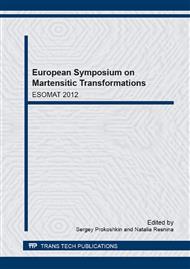p.177
p.183
p.189
p.195
p.200
p.206
p.212
p.217
p.222
Structural Mechanism of Reverse α → γ Transformation and New Functional Properties of Fe-Ni Austenitic Alloys
Abstract:
The structure of the metastable austenite Fe–32%Ni alloy quenched for martensite and subjected to the α→γ transformation at slow heating (to 593–773 K) with the formation of a nanocrystalline austenite of different orientation was investigated. Electron diffraction analysis has revealed that nickel-enriched nanocrystalline γ-phase obtain ordered L10 superstructure. Together with the γ-phase, there was detected the disperse ε-martensite with a hexagonal close-packed (hcp) lattice. Along with the realization of ordinary orientation relationships (ORs) of Kurdjumov-Sachs, between a matrix α-phase and an ordered γ-phase in the sample of Fe-32%Ni alloy after slow heating to 773 K there have been established Headley-Brooks Ors. Cyclic transformation promotes the improvement of many functional properties of steels (strength, coercive force, controlling of the thermal expansion coefficient and others).
Info:
Periodical:
Pages:
200-205
Citation:
Online since:
January 2013
Authors:
Price:
Сopyright:
© 2013 Trans Tech Publications Ltd. All Rights Reserved
Share:
Citation:


